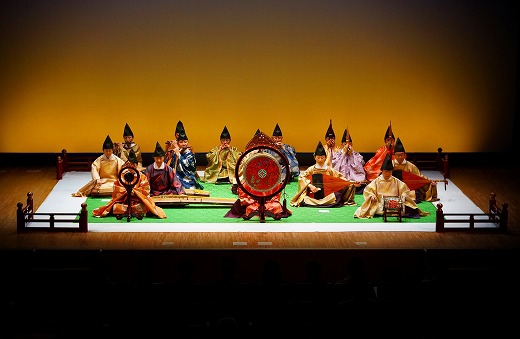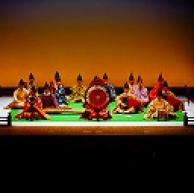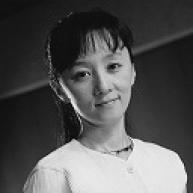Concert Hall ATM
- Concert
Gagaku – Japanese Court Music – from Times Past
Feast of the Seventh Night of the Seventh Moon
July 7 (Sat.),2018

» Flyer [PDF]
Reigakusha, Gagaku Ensemble
[Program]
Sukeyasu Shiba, reconst.: Rodai-rambu
(Zogei) Shiro-usuyo
(Kangen) Hyojo Netori, Etenraku
(Roei) Jisei
A-on sanben
(Zogei) Haya-bintatara
(Kangen) Oshokun
(Rambu and Imayo) Manzairaku and Ike no suzushiki
(Zogei) Iza-tachinam
Sukeyasu Shiba, reconst.: Soro-kodatsu (excerpts, version for instruments reconstructed after those of the Shoso-in (the eighth-century Imperial storehouse in Nara))
Kakucho choshi
Jo
Kodatsu
Satto
Mayumi Miyata: Umi (for U, a reconstructed shoso-in instrument)
Solo: Mayumi Miyata
Toru Takemitsu: In an Autumn Garden
Outline
Venue
Concert Hall ATM
Dates
July 7 (Sat.),2018
Organized by
Mito Arts Foundation
Ticket Information
Price
【All seats reserved】¥3,500, Youth (under25) ¥1,000
Open 16:30, Pretalk 16:45, Start 17:00
Ticket Purchase
Art Tower Mito
--Entrance Hall Tickets Sales
--Tickets Center TEL: (029)231-8000
--Web http://arttowermito.or.jp/tickets/ticket.html
e+ http://eplus.jp
Music Shop Kawamata TEL: (029)226-0351
Yamaha Music Retailing Mito TEL: (029)244-6661
Contact
TEL TEL 029-227-8118
Concert Hall ATM Production Section
【Organized by】
Mito Arts Foundation
Profile

Reigakusha
Gagaku ensemble
Reigakusha was established in 1985 as a group of professional gagaku (ancient Japanese court music) instrumentalists dedicated to the study and performance of the classical gagaku repertoire and the creation of new music for the ancient instruments. Led by the distinguished musician and composer Sukeyasu Shiba – a specialist in music for the ryuteki flute and biwa, a former member of the Music Department of the Imperial Household Agency, – Reigakusha includes about thirty members. Since its formation, Reigakusha has won a high reputation for its performances of the traditional gagaku repertoire, its revival of classic works that had disappeared from the repertoire over the past hundred years, its reproduction of facsimile instruments based on the ancient Chinese and Japanese gagaku instruments preserved in the Shoso-in, and for its commissioning of new works utilizing the traditional instruments by leading Japanese composers. At present Reigakusha,s repertoire consists of more than sixty ancient gagaku works, thirty new works in the classic tradition, twenty revived works (based on scholarly research into music that had long disappeared from the traditional repertoire), and a lot of major new works by contemporary composers as Toru Takemitsu, Toshi Ichiyanagi, Maki Ishii and Toshiro Saruya.
During the past decade, Reigakusha has received the invitation from the major concert halls such as the National Theater of Japan, Suntory Hall in Tokyo, Izumi Hall in Osaka, Kitara Hall in Sapporo, and also appeared at the major music festival such as the Kita-Kyushu International Music Festival, the Tsuyama International Music Festival and the Yatsugatake Music Festival. In October 1995 Reigakusha presented a special outdoor performance of Takemitsu,s In an Autumn Garden at Meiji Shrine in Tokyo.
In July 1996, Reigakusha was invited to Seattle, Tanglewood and the first Lincoln Center Festival in New York to present In an Autumn Garden by Toru Takemitsu. Also in October 1998, the Ensemble gave the UK premiere of In an Autumn Garden in Glasgow, Birmingham, Cambridge as well as at Queen Elizabeth Hall in London as a part of the Takemitsu Festival, “Spirit Garden”, artistically directed by Oliver Knussen. So far Reigakusha has held the concerts programmed the traditional pieces and contemporary pieces at Brussells, Cologne, Berlin, Oslo, Innsbruck, Amsterdam, Morocco, Volos and etc. Reigakusha was invited to the opening series of the Walt Disney Concert Hall in Los Angels (2004), the special concert “BEST OF BOULEZ”, celebrating the 80th Birthday of Pierre Boulez, presented by the Chicago Symphony Orchestra (2005) , the Salle Pleyel in Paris and the MITO Festival in Italy (2009) , the Music From Japan Festival in USA (2010), the National Gugak Center in Seoul and Busan (2015), and play with ENSEMBLE MODERN in Germany Frankfurt (2015).
http://www.reigakusha.com
https://www.facebook.com/reigakusha

Mayumi Miyata
Sho, U
Mayumi Miyata is distinguished by being one of the first artists to bring the traditional Oriental instrument the sho, to worldwide recognition. Through her virtuoso performances around the world, Ms. Miyata's artistry has helped expand awareness of the sho both in Japan and overseas and she can be credited with making it widely recognized not only as a traditional instrument but one that has a valid place in contemporary music.
Having graduated from Kunitachi College of Music in piano, Ms. Miyata studied gagaku, and in 1979 joined the gagaku ensemble at the National Theater of Japan. Since her debut Tokyo recital in 1983, she has been active as a soloist and stunned audiences with her performances in Paris, Amsterdam, New York, Seattle and Milan (La Scala), Vienna (Konzerthaus) and at festivals such as Salzburg, Luzern, Rheingau, Schleswig-Holstein, Avignon, Tanglewood, London Proms, Milano Musica, Festival d'Automne a Paris, Donaueschinger Musiktage, Wien Modern, Octobre en Normandie, Darmstadt International Summer Course, Festival Extasis (Geneva), Musica Viva (Munich), Musik Aktive (Dortmund), Orleans International Music Week, Pacific Music Festival Sapporo, Takefu International Music Festial and Akiyoshidai International Contemporary Music Festival.
Although the sho has its origins in gagaku, and it is this music with which it is traditionally associated, Mayumi Miyata is highly acclaimed for her performances of compositions by many of the world's leading contemporary composers. She has worked particularly closely with John Cage, having performed the world premiere of all of Cage's Two3 for sho and Conch in Italy in 1992, and is also associated with composers such as Toru Takemitsu, Toshio Hosokawa, Helmut Lachenmann, Paul Méfano, Klaus Huber, Pierre-Yves Artaud, Zsigmond Szathmáry, Toshi Ichiyanagi, Maki Ishii, and Joji Yuasa, having been invited to premiere many of their works. Such highlights include major works such as Takemitsu's evocative “Ceremonial -An Autumn Ode-” with Seiji Ozawa and the Saito Kinen Orchestra and Hosokawa’s “Utsurohi Nagi” performed with the WDR Symphony Orchestra, Cologne in 1996 and Hosokawa’s “Could and Light” with Deutsche Radio Philharmonie Saarbrücken Kaiserslautern in 2008. In 1997 Ms. Miyata participated in the tremendously successful world premiere in Hamburg of Lachenmann's major operatic work “The Little Match Girl”, which was followed by performances at Staatstheater Stuttgart, Opera de Paris, Deutsche Oper Berlin and Ruhr Triennale. In 2007 Ms. Miyata has premiered Gerhard Stabler's new work for sho and Orchestra in Duisburg.
Furthermore her recent orchestra engagements include BBC Symphony Orchestra with Kazushi Ono, Orchestre Symphonique de la Monnaie with Kazushi Ono, NHK Symphony Orchestra with Charles Dutoit for their European tour in St. Petersburg, Moscow, Vienna, Munich and Berlin, New York Philharmonic with André Previn, PMF International Orchestra with PMF International Orchestra, Tanglewood Festival Orchestra with Seiji Ozawa, Czech Philharmonic Orchestra with Vladimir Ashkenazy, Bamberger Symphoniker with Jonathan Nott, Orchestre National de Lyon with Jun Maerkl, Munich Chamber Orchestra with Alexander Liebreich.
Highlights of Ms. Miyata's career include such diverse engagements as her performance of the Japanese National Anthem at the Opening Ceremony of the Nagano Winter Olympic Games and her work with Björk on the soundtrack to Matthew Barney's film Drawing restraint 9, in which she appears playing her instrument.
She was nominated as cultural ambassador by the Japanese Agency for Cultural Affairs and as such toured Europe giving concerts, workshops and collaborating with local artists and composers, promoting knowledge of the sho overseas.
